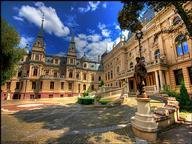Quiz Answer Key and Fun Facts
1. At the conclusion of WWII, the western border of Poland was shifted approximately one hundred and fifty miles to the west. What was this new border called?
2. After the war, the Soviets installed as the new Defense Minister in Poland a Russian general. The Poles were insulted not only because a Russian had been placed in charge of the Polish military, but also because this particular general had been the leader of the Soviet forces who had failed to come to the aid of the Warsaw resistance fighters. Who was he?
3. In February of 1956, this Soviet Communist leader denounced Stalin at the Twentieth Congress of the Soviet Communist party. His denunciation led to "the thaw" throughout Eastern Europe, including Poland. Who was this Soviet leader?
4. This individual was head of the Polish Communist Party from 1947-56. He was an ardent Stalinist, known for his brutal use of the secret police. Who was he?
5. When he became First Secretary of the Polish Communist Party in 1956, it nearly resulted in military intervention by the Soviet Army. However, the fact that his rise to power was supported by Mao Zedong, and that the Polish Army made clear that they were willing to fight to defend Poland's right to determine its own Communist leadership resulted in the Soviet Union backing down on its threat to invade.
6. True or False? Poland was the only Eastern European country in which there almost no collectivization of agriculture during the Communist years.
7. On October 16, 1978, this archbishop of Krakow, who became Pope John Paul II, was elected by the Roman Catholic College of Cardinals as the new pope. What was his name?
8. This group was organized in 1976 by Jacek Kuron and Adam Michnik to provide legal assistance to workers being persecuted for having taken part in strikes. It was part of growing phenomenon termed the "self-organization of Polish Society." Marginally legal, it provided vital support to Solidarity. What was the name of this group?
9. In 1980, Solidarity strikers initially succeeded in getting the government to sign an agreement which recognized the right of workers to strike and recognized Solidarity as a legal independent trade union.
10. This Communist leader declared martial law in Poland on December 13, 1981, established the Military Council of National Salvation to administer the country, and suspended Solidarity. Who was he?
11. Which of the following persons was a leader of Solidarity?
12. On March 7, 1989 the Polish authorities finally conceded that the massacre of some 15,000 Polish officers early in World War II had been a Soviet NKVD atrocity, not a Nazi German one. Where did this massacre take place?
13. Who became the first post-Communist era president of Poland?
14. The Polish army did not contribute troops for the invasion of Czechoslovakia in 1968 by Warsaw Pact troops. True or false?
15. In 1945, this political party led by Stanislaw Mikolajczyk, posed the greatest challenge to Communist domination of Poland. What was the name of this political party?
Source: Author
allieetal
This quiz was reviewed by FunTrivia editor
bloomsby before going online.
Any errors found in FunTrivia content are routinely corrected through our feedback system.

